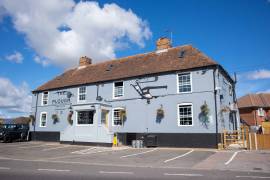250 years of the black stuff

All the statistics about Guinness are literally staggering. It's on sale in 150 countries and brewed under licence in 50. Twelve brews a day are produced in Dublin alone and the brewery in St James's Gate uses 100,000 tonnes of malt and 15,000 tonnes of roasted barley a year, with eight million litres of water from the Wicklow Mountains every day.
But the most remarkable fact is that, after 250 years of brewing in Dublin, Guinness shows no signs of flagging. In the age of global lager brands, dark Irish stout is still a worldwide phenomenon. Sales are increasing — and that includes the Irish homeland.
Following a difficult decade or two, which saw lager volumes on the increase, sales of Guinness are rising by between 2% and 3% a year. It accounts for 60% of all draught beer sold in Ireland. Although the beer is no longer brewed in London — the Park Royal site closed in 2005 — the British are the biggest consumers of Guinness in the world.
On 24 September this year, Guinness drinkers everywhere will be asked to "Raise a glass to Arthur". It's not certain, but that date could be Arthur Guinness's birthday. What is not in dispute is that 2009 marks the 250th anniversary of Guinness in Dublin. In 1759 Arthur signed a lease on a small and dilapidated brewery in St James's Gate. Such was his confidence in the future that the lease ran for 9,000 years. The rent was £45 a year.
It was nevertheless a risky business. There were 30 other breweries in the St James's Gate area of Dublin alone, with scores in other parts of the city. Arthur survived and grew the business dramatically when he took the fateful decision in 1799 to stop brewing ale and concentrate on porter and stout.
Vast amounts of London-brewed porter and its stronger or stouter version were flooding into Ireland, threatening the fortunes of local breweries. Arthur Guinness took the British on at their own game. Such was his success that by the 1920s the company he handed on to his sons and grandsons became the biggest brewery in the world.
As early as 1801, Arthur had developed a stronger version of his beer for export to the Caribbean. It was called West India Porter and it was this beer that was to forge the company's international base. When he died in 1803 he left £23,000, a fortune in its day. His son, Arthur Guinness II, vigorously built both the domestic and international side of the business. He used the Irish canal system to send porter and stout to all parts of the island while he turned West India Porter into Foreign Extra Porter Stout, exported to all parts of the British Empire and to the US. Today, known as Foreign Extra Stout, it represents 45% of all Guinness brewed and sold worldwide. FES in dehydrated syrup form — known as "essence" — is sent to breweries in Africa and other countries where barley is hard to grow and blended with a pale beer made from sorghum or maize to form stout for local markets.
Arthur Guinness II was an astute businessman. He became Governor of the Bank of Ireland and it was from that position that he formulated a new recipe for Guinness beers. In the 19th century, tax was paid not on alcohol but on malt. The British brewers used coloured malts to produce porter and stout but Arthur II switched to using around 10% unmalted — and untaxed — roasted barley.
The result was a radically different style of beer, with a burnt fruit and grain character. The style was dubbed "dry Irish stout". It went on to conquer the world and, before duty was levied on alcoholic strength, saved Guinness a fortune in tax to the less-than-popular British Government that ruled the whole of Ireland.
The story of Guinness is told in the Storehouse, a magnificent museum and visitor centre that was once the brewery's fermentation and storage block. The Storehouse opened in 2000 at a cost of E38m and is now Ireland's biggest tourist attraction, drawing around one million people a year. As well as history, the Storehouse contains fascinating old brewing vessels, samples of malt, roasted grain, hops, yeast and water that make the beer, and a bar at the top of the building that gives a breathtaking view of the Dublin skyline as well as a free glass of black gold.
For many, the most fascinating aspect of the tour is the famous ads for Guinness that spanned the 1930s and post-war world until the "drinks police" decreed it was no longer permissible to say "Guinness is Good for You". The collection includes the posters designed by John Gilroy showing elephants, horses and other animals pulling drays of stout. The most iconic is the toucan poster showing the bird with two glasses of stout in its beak, with words penned by crime writer Dorothy L Sayers: "If he can say as you can, Guinness is good for you, how grand to be a toucan — just think what toucan do".
The toucan is flying again this year as part of the 250th celebrations. There will be concerts over the world, including gigs in London. Watch out for them and make sure you raise a glass to Arthur, the brewer whose legendary black beer still refreshes millions of drinkers every day.













